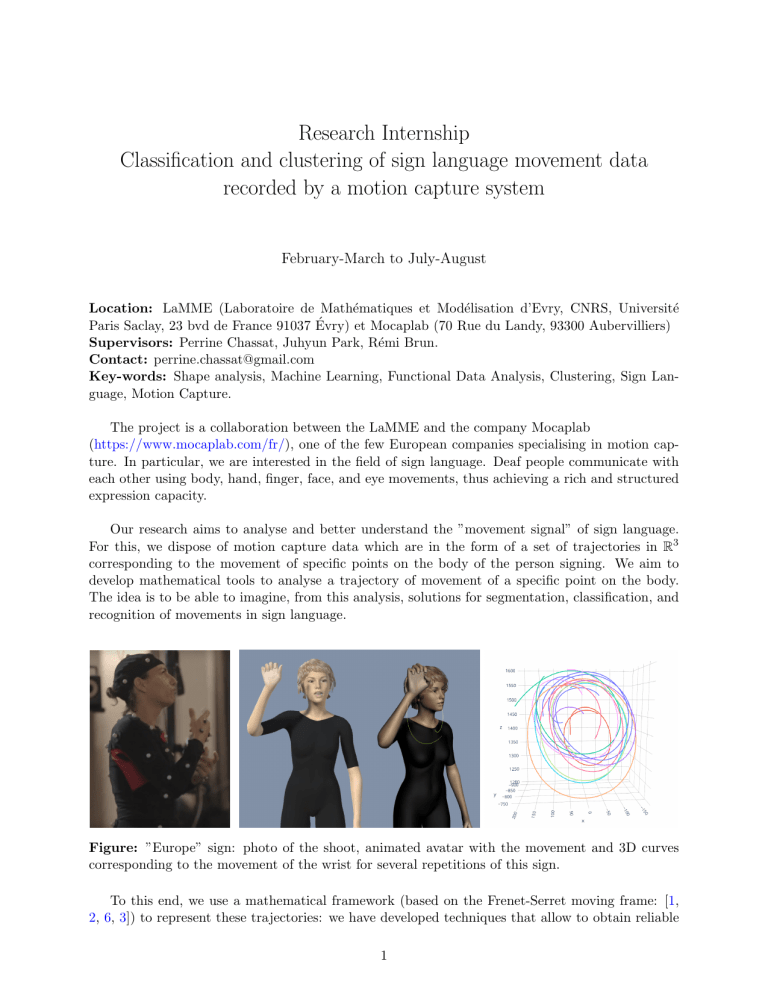
Research Internship Classification and clustering of sign language movement data recorded by a motion capture system February-March to July-August Location: LaMME (Laboratoire de Mathématiques et Modélisation d’Evry, CNRS, Université Paris Saclay, 23 bvd de France 91037 Évry) et Mocaplab (70 Rue du Landy, 93300 Aubervilliers) Supervisors: Perrine Chassat, Juhyun Park, Rémi Brun. Contact: perrine.chassat@gmail.com Key-words: Shape analysis, Machine Learning, Functional Data Analysis, Clustering, Sign Language, Motion Capture. The project is a collaboration between the LaMME and the company Mocaplab (https://www.mocaplab.com/fr/), one of the few European companies specialising in motion capture. In particular, we are interested in the field of sign language. Deaf people communicate with each other using body, hand, finger, face, and eye movements, thus achieving a rich and structured expression capacity. Our research aims to analyse and better understand the ”movement signal” of sign language. For this, we dispose of motion capture data which are in the form of a set of trajectories in R3 corresponding to the movement of specific points on the body of the person signing. We aim to develop mathematical tools to analyse a trajectory of movement of a specific point on the body. The idea is to be able to imagine, from this analysis, solutions for segmentation, classification, and recognition of movements in sign language. Figure: ”Europe” sign: photo of the shoot, animated avatar with the movement and 3D curves corresponding to the movement of the wrist for several repetitions of this sign. To this end, we use a mathematical framework (based on the Frenet-Serret moving frame: [1, 2, 6, 3]) to represent these trajectories: we have developed techniques that allow to obtain reliable 1 estimates of the kinematic and geometric descriptors of these trajectories (the curvilinear velocity, the curvature and the torsion of a point’s trajectory in R3 ). These motion descriptors are in the form of functions corresponding to variables evolving over time, i.e. along the motion trajectory. From these descriptors, we propose a new distance between motion trajectories. This allows, among other things, to estimate an average trajectory within a set of trajectories corresponding to the same sign, and to model the geometric and kinematic variations by deformation functions with respect to this average. This approach shares similarities with ”Shape analysis” approaches ([7, 4], for examples see the library https://geomstats.github.io/). The objective of the internship is to explore methods of classification and clustering of signs based on these descriptors and the proposed distance. For this purpose, we have a database of 10 repetitions of 60 monomanual signs (half of the repetitions being made by a deaf woman and the other half by a male interpreter). First, we will analyse the movement of a point on the wrist (i.e. a single trajectory per sign). It will be interesting to compare these results with methods involving other distances (e.g. the distance using the square root velocity function [4, 8, 5]) found in the literature, and to characterise the variability of the observed movements. In a second step, we will use the developed clustering method to try to answer one of our other problems, which is to determine an interesting segmentation of the sign language movement trajectory. More precisely, we seek to determine a number of motion trajectory segments, smaller than the number of signs, which allow us to decompose any sign trajectory into some of these segments. From the developed clustering method, we will try to determine the segmentation that maximises the length of these segments while minimising the total number of segments in the set of signs, i.e. the number of clusters. To do this, we could have access to another larger corpus of Mocaplab data in which there will not necessarily be several repetitions of the same sign. The motion data are not ”classical Euclidean” data, and we are working at the interface of statistics, functional data analysis, and geometric shape analysis. The work done will be integrated into a Python library under development, and will contribute to a publication. For more details, please contact us. Candidates with a previous background in applied mathematics, the ability to code in Python, and who are willing to explore motion data are encouraged to apply. References [1] Nicolas J.-B. Brunel and Juhyun Park. “Removing phase variability to extract a mean shape for juggling trajectories”. In: Electronic Journal of Statistics 8.2 (2014), pp. 1848–1855. doi: 10.1214/14-EJS937E. [2] Nicolas J.-B. Brunel and Juhyun Park. “The Frenet-Serret Framework for Aligning Geometric Curves”. In: Geometric Science of Information. Ed. by Frank Nielsen and Frédéric Barbaresco. Cham: Springer International Publishing, 2019, pp. 608–617. 2 [3] Perrine Chassat, Juhyun Park, and Nicolas Brunel. “Analysis of Variability in Sign Language Hand Trajectories: Development of Generative Model”. In: Proceedings of the 8th International Conference on Movement and Computing. MOCO ’22. Association for Computing Machinery, 2022. doi: 10.1145/3537972.3537999. [4] J. S. Marron et al. “Functional data analysis of amplitude and phase variation”. In: Statistical Science 30 (4 2015), pp. 468–484. doi: 10.1214/15-STS524. [5] Juhyun Park and Jeongyoun Ahn. “Clustering multivariate functional data with phase variation”. In: Biometrics 73 (2017), pp. 324–333. doi: 10.1111/biom.12546. [6] Juhyun Park, Nicolas Brunel, and Perrine Chassat. “Curvature and Torsion estimation of 3D functional data: A geometric approach to build the mean shape under the Frenet Serret framework”. In: (2022). doi: 10.48550/arxiv.2203.02398. [7] Anuj Srivastava and Eric P. Klassen. Functional and Shape Data Analysis. Vol. 49. Journal of Quality Technology, 2017. doi: 10.1080/00224065.2017.11918007. [8] J. Derek Tucker, Wei Wu, and Anuj Srivastava. “Generative models for functional data using phase and amplitude separation”. In: Computational Statistics and Data Analysis 61 (2013), pp. 50–66. doi: 10.1016/j.csda.2012.12.001. 3


